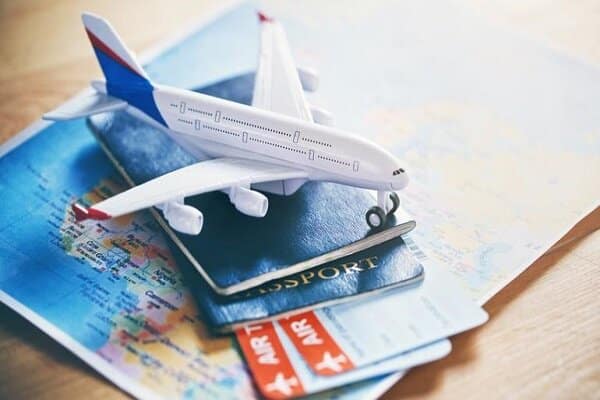Why is it so difficult to find cheap flights? Online travel search engines such as Google Flights, Kayak, and Expedia were designed to simplify and improve the flight purchasing experience, and they have done so in many ways. However, airlines continue to devise techniques, such as hidden fees and convoluted pricing classes, to make it more difficult to determine whether the price you see is the price you’ll pay.
Is booking “basic economy” fares preferable? To select low-cost airlines? Should I book directly with the airline or with a third party? If you’re feeling overwhelmed, don’t give up hope: even we travel professionals struggle to untangle these tangles to get the best, most economical ticket. Here we share our best, hard-won knowledge, providing a step-by-step guide to finding cheap plane tickets. Even if you only use a few of these suggestions for how to book a flight, they can make a great impact when planning and booking your next trip.
This guide focuses on booking domestic (inside the United States) flights, but the majority of the advice also applies to foreign tickets.
Steps On How to Book a Flight
Movies, television shows, friends, and family can all motivate us to fly to any location. Take their lead and book a ticket. Booking a flight online will undoubtedly offer you a feeling of independence. It’s not complicated. Follow these simple steps to book a flight ticket online.
Booking an airplane ticket can appear challenging when there are so many websites, airlines, and travel agents to select from. Flight prices are continuously changing, making booking even more challenging. However, with a little knowledge and agility, you’ll be able to easily book your next plane ticket.
To book a flight ticket online, follow the steps outlined below.
Step #1: Look for flight tickets ahead of time.
Buying your tickets ahead of time can help you get them at a reduced price. The optimal time to book a domestic flight is between 112 and 21 days before departure. The best time is 54 days ahead of time. The lowest fare cannot be guaranteed if you book 54 days in advance, though.
When planning an overseas flight, plan ahead of time, especially if your destination is rural and has limited flight connectivity.
If you are traveling to a popular place during a popular season, such as Spain in the spring or fall, you should book as soon as possible. Because this flight is in high demand, a fare drop is doubtful.
Step #2: Visit all of the available airline websites.
Before booking a reservation, check all websites for the lowest airfare or offers. This is especially handy if your travel dates or destination are adjustable, allowing you to take advantage of any available bargains.
Airlines will periodically notify customers of sales via their websites or emails. Subscribe to your favorite airlines’ newsletters or visit their websites to look for offers.
Step #3: Fill out your information on an aggregator website.
Enter your travel details into a website that searches multiple airlines. The website will show you a variety of flight alternatives for your selected location and dates, which you may sort by price, airline, or trip length.
Many aggregator websites allow you to enter multiple destinations and search for flights on multiple dates at the same time. If you have the time, look into a few aggregator websites. Some websites may display different pricing, so search around to get the best offer.
Step #4: Select your stops
Many flights, particularly those too distant locations, will require airport layovers. It is occasionally necessary to change planes and go through security again. Remember how many stops you are okay with while looking for flights.
Examine the duration and time of day of the stops as well. You might be able to locate a cheaper flight if you’re ready to add an extra layover. However, examine whether the stopover’s length and duration are worth the money saved.
Step #5: Select a seat
Many airlines allow you to choose your seat when you book. When ordering plane tickets, make sure you select seats for all people. You have the option of sitting together, assuming there is enough place for your group, and whether you prefer an aisle, window, or middle seat.
Seat enhancements, such as increased legroom, may be available for an additional price. If you are unable to select your seat while booking, you may be able to do so when checking in. Contact your airline to see what options are available if you have a special seat preference or need to sit with your travel companions, such as when flying with a youngster.
Step #6: Select or decline your add-ons.
Toward the end of the booking process, your airline may recommend add-ons such as hotels or car rentals. You can book these alongside your flight ticket or separately.
Do some online research before selecting an add-on, such as a hotel stay or vehicle rental, to ensure your airline offers a reasonable value.
Step #7: How to Book Tickets for Pets and Special Accommodations
The Centers for Disease Control and Prevention (CDC) in the United States has issued a temporary restriction on dogs (carry-on or checked) traveling to the United States from a nation with a high risk of dog rabies, including highly trained service dogs.
Only assistance dogs with a valid CDC Dog Import Permit or who meet the CDC U.S. immunization and microchip standards may fly to America. Contact Special Assistance if you want to travel with a cat or dog in a cabin from a high-risk nation.
If you require special accommodations for your flight, such as a wheelchair, notify the airlines when booking. If you are not required to submit this information during your online booking, contact your airline.
Step #8: Select whether to add or deny insurance.
During the booking process, airlines may request that you purchase insurance. Examine the small print to see if your flight and trip require insurance.
Your employment, healthcare, or credit card may provide insurance coverage.
Step #9: Purchase your plane ticket.
Check that all of your booking information is correct. If everything appears to be in order, proceed with your payment. Pat yourself on the back!
Step #10: Verify your receipt.
After you book, your airline should send you an email with your receipt and ticket confirmation. If you do not receive it within a few hours of booking, contact your airline. Save an email copy of the receipt somewhere safe. It’s a good idea to print it and save a hard copy.
10 Things to Think About Before You Book a Flight
When you book a flight, there are many factors. Travel dates, baggage allowances, layovers, and vaccine requirements are all important considerations. But, if you take it one step at a time, it doesn’t have to be daunting. Here’s a comprehensive list of ten things to think about before booking a flight.
#1. Flight Schedule and Travel Dates
This suggestion may seem apparent, but it is important enough to mention again. Before you book your flight, double-check that the dates and hours correspond to your schedule. This is especially important if you’re going through numerous time zones or boarding a red-eye flight.
I made the error of scheduling a red-eye flight from Seattle to Boston at midnight on a Saturday rather than a Sunday a few years ago. I was so intent on booking on a specific day that I didn’t understand the early morning flight meant I’d be traveling a full 24 hours ahead of schedule. So, I found a cheap flight but ended up missing a full day of my trip. The lesson has been learned.
#2. Time spent in transit and on layovers
When booking a flight, one of the first things you should look at is the overall transit time. A reduced journey time is certainly more enticing in the case of several stops. We have more time at our destination if we spend less time traveling.
On the other hand, be wary of excessively short transit times. You can sometimes make a 40-minute layover work, but if the airline is late or there is bad weather, you may be creating problems. Domestically, I’ve found that a 1 to 1.5-hour layover is excellent. If you have an international layover or are coming into the United States from another country, allow an extra hour for immigration, customs, and re-checking your luggage if necessary.
#3. Layout and Location of Layover
If you cannot fly direct, selecting a decent layover airport is critical to a smooth travel day. Consider the time of year when selecting a layover. By all means, avoid flying via Minneapolis in January or Florida during hurricane season.
Pull up an airport map to get a sense of its layout. It should be simple to navigate if the hub has a single terminal or offers quick access between gates. If the terminals are divided by buildings or need a train or shuttle, getting to your next gate will be substantially more difficult.
#4. Flight Capability
Checking the flight’s prior performance is an excellent way to choose from a list of alternative flights. Airlines such as United and American Airlines let you utilize this data to select an aircraft with a high percentage of on-time flights.
To find flight performance on the United website, go to “Transit Time.” A little box containing the flight’s monthly on-time, late, and canceled statistics will appear. When booking with American, similarly, click on the “Details” option. The performance of the flight will be presented in the upper right-hand corner, with a percentage of on-time and late flights.
#5. Departure and Arrival Airports
When flying into a major city, you may have access to many airports. If you’re unfamiliar with the location, do some preliminary study about the city and its airports. Which airport is the most convenient for your event, business conference, or hotel? Which airport provides public transit to your area? Determine what works best for your travel requirements.
The same is true of your departing airport. I have a choice between a tiny airport near my house and a large airport that requires a two-hour bus trip from where I reside in Maine. The airport I choose is frequently determined by the cost of the flight and the type of travel, but I constantly compare flights from both airports to find the best fit for my trip.
#6. Economy Classification
There is no longer a single sort of economy class. There’s a lot to learn about the fare you choose, from basic economy to the main cabin. You may be tempted to book the lowest flight possible but keep in mind that basic economy is not enjoyable. When I recently booked a ticket through a third-party booking site, I discovered this the hard way. I was pleased to locate a cheap flight, only to find out that my low-cost ticket meant I couldn’t select a seat and couldn’t bring a carry-on suitcase.
I could have carried on my bag for free and sat in a coveted seat if I had done my research and paid a little bit more. To summarize, make sure you’re familiar with the airline’s economy class options to ensure it’s a compromise you’re willing to make.
#7. Reputation of an Airline
The reputation of an airline, from its customer service to its in-flight amenities, is essential. When booking with a new airline, do your homework before committing. How do they treat their clients? Are WiFi and in-flight entertainment available? Are snacks and beverages provided? What size are the seats? These items may not seem vital right now, but trust me when you’re five hours into a flight with a grumpy flight attendant, uncomfortable seats, and no snacks, you’ll reconsider.
#8. Allowance for Baggage
We rarely fly without bags, so knowing an airline’s baggage allowance is essential. If you frequently pack a wheeled carry-on, look into the maximum size allowed for carry-on suitcases and whether or not the restriction is strictly enforced.
Check the airline’s baggage fees before booking if you’re a chronic over-packer or bringing big things. Baggage costs can make or break a trip’s budget. For example, on ski trips, I always aim to go with Southwest Airlines because they allow you to check skis for free. Given that most airlines charge $70 or more for excess baggage, it’s a deal I can’t pass up.
#9. The Season
We cannot always travel in great weather, no matter how much we would like to. Having said that, we do have some say about when we go. If you despise canceled flights and getting stranded in blizzards, staying grounded during the holidays may be worthwhile.
If you must travel during the winter season, as I frequently do, consider getting the first flight out in the morning. The first flight is difficult to get up for, but the plane is usually already there from the night before. You won’t have to wait for a plane and you’ll be able to leave on schedule.
#10. Requirements for a Passport, Visa, and Vaccinations
If you’re traveling internationally, the first thing you should do is research a country’s passport, visa, and vaccine requirements. Before you commit to the hefty cost of an overseas flight, make sure you can meet the entry requirements for the country. Checking with the CDC to see if there are any diseases you should be aware of can also be beneficial. You’ll be able to book your flight with confidence once you’ve gathered all of the necessary information.
When is the Best Time to Book a Flight?
When flying within the United States, the best and most cost-effective days to fly are usually midweek, on Tuesday or Wednesday.
Which Bags Are Permitted on the Plane?
Carry-on luggage must weigh no more than 35 pounds and be no more than 10 inches deep, 16 inches wide, and 24 inches tall.
Is It Possible to Bring Food on a Plane?
Solid food (but not liquids or gels) can be transported in your carry-on or checked bag. Food products greater than 3.4 oz in liquid or gel form are not permitted in carry-on bags.
Conclusion
Finding cheap flight tickets is difficult. Whatever you read about “travel hacks” and other ways to drastically reduce the cost of airfare, the best approach for most people to get the best price is via endurance and arithmetic.
Did you find this blog to be useful? If so, please express your ideas in the section below. For additional information on how to book a flight ticket online, please contact us by clicking here. We would be pleased to answer your questions.
Related Articles
- How Far in Advance Should I Book a Flight in 2023?
- FLEXIBLE DATES FLIGHTS: How To Get Them
- 20 CHEAPEST COUNTRIES TO FLY TO IN 2023
- WHAT DAY ARE FLIGHTS CHEAPEST TO BOOK? All You Need To Know.
- BEST FLIGHT BOOKING APPS IN 2023






